The Biosurgery Equipment Market is estimated to be valued at USD 28.2 billion in 2025 and is projected to reach USD 44.6 billion by 2035, registering a compound annual growth rate (CAGR) of 4.7% over the forecast period.
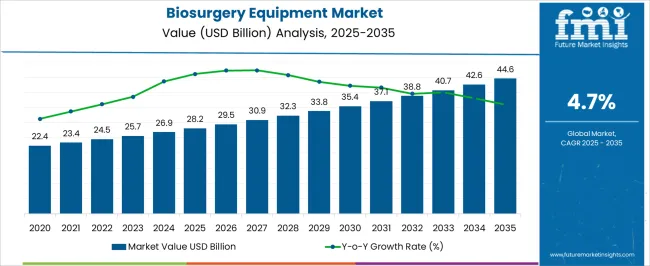
| Metric | Value |
|---|---|
| Biosurgery Equipment Market Estimated Value in (2025 E) | USD 28.2 billion |
| Biosurgery Equipment Market Forecast Value in (2035 F) | USD 44.6 billion |
| Forecast CAGR (2025 to 2035) | 4.7% |
The biosurgery equipment market is advancing steadily, supported by the rising demand for innovative surgical solutions that enhance healing, reduce recovery times, and improve patient outcomes. Growth is being influenced by increasing surgical volumes globally, particularly in orthopedics, cardiovascular, and general surgery, where minimally invasive techniques are gaining prominence.
Rising prevalence of chronic diseases and trauma-related conditions is fueling the adoption of advanced biosurgery equipment, while technological improvements in biomaterials and regenerative solutions are creating further opportunities. Hospitals and healthcare systems are placing greater emphasis on patient safety and cost efficiency, driving demand for products that reduce operative complications and improve procedural success rates.
Additionally, favorable reimbursement policies in developed regions and growing investments in healthcare infrastructure in emerging economies are expanding accessibility to these advanced surgical solutions As innovation continues to focus on bioresorbable materials, tissue engineering, and precision instruments, the biosurgery equipment market is expected to experience long-term growth, positioning itself as a key enabler of next-generation surgical care worldwide.
The biosurgery equipment market is segmented by product type, application, end users, and geographic regions. By product type, biosurgery equipment market is divided into Bone Graft Substitute, Surgical Sealants, Hemostatic Agents, Soft Tissue Management, and Adhesion Barriers. In terms of application, biosurgery equipment market is classified into Cardiovascular, Orthopedic, Neurological, Urology, General Surgery, Plastic Surgery, and Gynecological. Based on end users, biosurgery equipment market is segmented into Hospitals, Clinics, Ambulatory Surgical Centers, Diagnostic centers, Cardiac Catheterization Laboratories, and Home Care Settings. Regionally, the biosurgery equipment industry is classified into North America, Latin America, Western Europe, Eastern Europe, Balkan & Baltic Countries, Russia & Belarus, Central Asia, East Asia, South Asia & Pacific, and the Middle East & Africa.
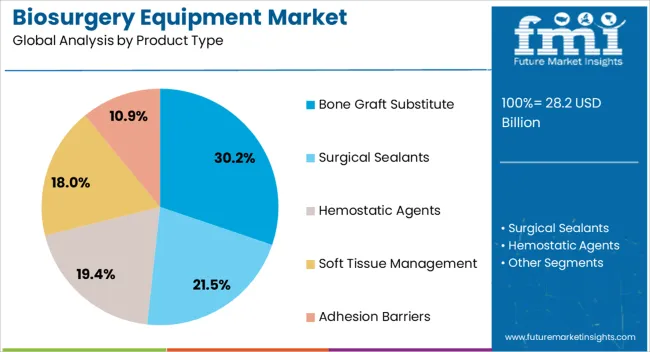
The bone graft substitute segment is expected to account for 30.2% of the biosurgery equipment market revenue share in 2025, making it the leading product type. This leadership is being driven by the increasing need for effective solutions in orthopedic and spinal surgeries, where bone repair and regeneration are critical. Bone graft substitutes offer significant advantages such as reduced surgical morbidity and elimination of the risks associated with autograft harvesting, making them a preferred choice among surgeons.
Advances in biomaterials, including ceramics, polymers, and bioactive composites, have enhanced their biological performance, improving patient recovery and long-term outcomes. Growing prevalence of conditions such as osteoporosis, fractures, and degenerative bone disorders is further stimulating demand.
The ability to provide consistent and reliable results across diverse clinical settings has strengthened their role in modern surgical practice With rising investment in research aimed at developing synthetic and tissue-engineered substitutes, the segment is positioned to maintain its dominance by meeting both clinical requirements and regulatory standards for safe and effective bone repair.
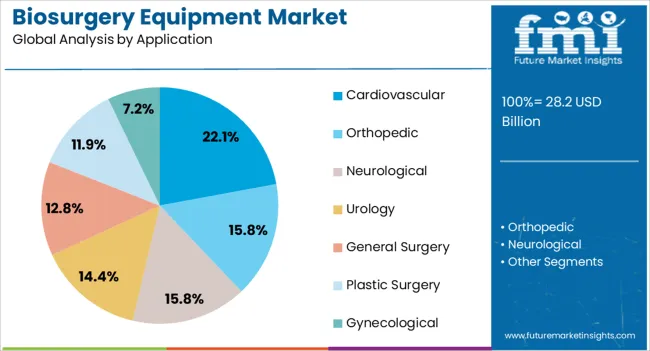
The cardiovascular application segment is projected to capture 22.1% of the biosurgery equipment market revenue share in 2025, establishing itself as a significant contributor. Its growth is being supported by the increasing global burden of cardiovascular diseases, which remain the leading cause of mortality worldwide. Biosurgery equipment plays a critical role in managing complex cardiovascular procedures by enabling precise control of bleeding, promoting effective tissue sealing, and improving surgical outcomes.
Innovations in hemostatic agents, surgical sealants, and regenerative products are being incorporated into cardiovascular surgeries, enhancing safety and procedural efficiency. Rising adoption of minimally invasive and catheter-based interventions has further expanded the scope of biosurgical applications within this domain.
Hospitals and cardiac centers are prioritizing equipment that improves operative precision while minimizing risks of complications such as excessive bleeding or prolonged recovery As healthcare systems invest in advanced cardiac care infrastructure, demand for specialized biosurgery equipment tailored to cardiovascular interventions is expected to grow, reinforcing the segment’s position in the overall market.
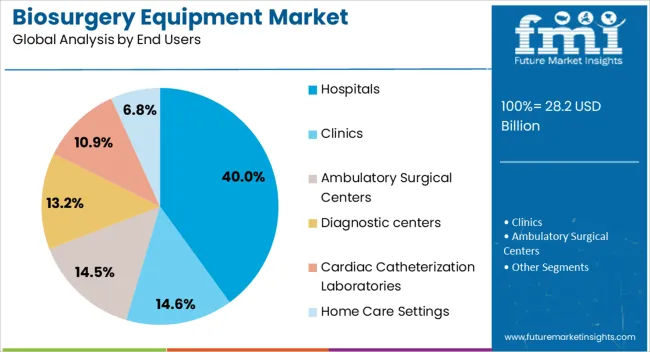
The hospitals segment is anticipated to hold 40.0% of the biosurgery equipment market revenue share in 2025, making it the leading end-user category. This dominance is being reinforced by the high volume of complex surgical procedures performed in hospital settings, which require reliable and advanced biosurgery solutions. Hospitals are increasingly adopting biosurgery equipment to improve surgical precision, reduce intraoperative complications, and ensure faster patient recovery.
The availability of specialized surgical units and advanced operating infrastructure enables wider utilization of innovative biosurgery tools and materials. Rising healthcare expenditure, coupled with a growing emphasis on patient safety and outcome-based care, is further accelerating adoption.
Hospitals also benefit from access to structured procurement processes and partnerships with medical device companies, allowing continuous integration of new technologies As the demand for minimally invasive procedures rises, hospitals are expected to remain the primary users of biosurgery equipment due to their ability to deliver comprehensive surgical care across multiple specialties, ensuring sustained growth in this segment.
In the ancient time when people were infected by germs resistant to antibiotics they were treated with the use of living organisms such as fly larvae which help in disinfect the wounds by eating the dead and rotten flesh. They also helps in growing new tissues in the wound by introducing natural antibiotics.
From this ancient approach surgeons invented biosurgery technique, also known as maggot debridement therapy or larval therapy. Biosurgery is an adjunct to whole treatment methods mainly for debridement and perioperative blood management.
The biosurgery includes biologic and synthetic materials that are used during surgery in order to eliminate the complications, improve surgical practices and to meet various surgical needs such as prevent excess bleeding, reduce the risk of infection, debridement of necrotic, slough, devitalized wounds or tissues and defects.
Moreover, biosurgery products improve the speed, consistency and enhance efficiency of surgeons with the use of various biomaterials that helps in reduce intra-operative and post-operative complications.
Biosurgery products are used to treat various chronic wounds such as osteomyelitis, leg ulcers, burns, malignant wounds, infected surgical wounds, abscesses and infected surgical wounds. Biosurgery equipment's also helps in preventing intraoperative air leaks and cerebrospinal fluid preservation leakage during thoracic, spinal and cranial surgery.
High investment in the healthcare sector, rise in spine injuries, increase in disease rates which indicate high volume of surgical procedures, accurate delivery of the product, product innovation such as microfibrillar collagen hemostat & fibrin sealant, plasma based & multi-usage products, rapid launch of novel products and approval for investigational products are the major driver for the growth of global biosurgery equipment market.
However, high cost of surgery, side effects with treatment such as venous bleeding and stringent government regulations for product approval and patient preference over minimally invasive procedures may hamper the growth of biosurgery equipment market in near future.
Based on product type, surgical sealants and hemostatic agents are the most common type of biosurgery products owing to its thicker matrix, flexibility, efficacy, strength, consistency, absorbable particles and positive patient outcomes.
Fibrin sealant is used as an adjunct to hemostasis for control soft tissue bleeding during surgery such as pelvic, non-cardiac thoracic and intra-abdominal surgery when standard surgical approach is impractical or unsuccessful.
With increase in the healthcare expenditure various companies are entering into new market with novel technology in the field of biosurgery such as coated mesh with polypropylene for soft tissue repair to enhance their market share which will flourish the growth of biosurgery equipment market in near future.
Depending on geographic region, biosurgery equipment market is segmented into seven key regions: North America, Latin America, Eastern Europe, Western Europe, Asia Pacific, Japan, and Middle East & Africa. North America held largest share in the biosurgery equipment market followed by Europe, Japan and Asia Pacific owing to high incidence of surgeries,reimbursement for biosurgery, rise in research & development activitiesand developed healthcare infrastructure.
The developing nations in Asia Pacific, Middle East and Africa hold huge potential for growth in the biosurgery equipment market, due to increase in the awareness about biosurgery equipment's among surgeons, rising per capita income and living standards along with increase healthcare expenditure.
The report is a compilation of first-hand information, qualitative and quantitative assessment by industry analysts, inputs from industry experts and industry participants across the value chain.
The report provides in-depth analysis of parent market trends, macro-economic indicators and governing factors along with market attractiveness as per segments. The report also maps the qualitative impact of various market factors on market segments and geographies.
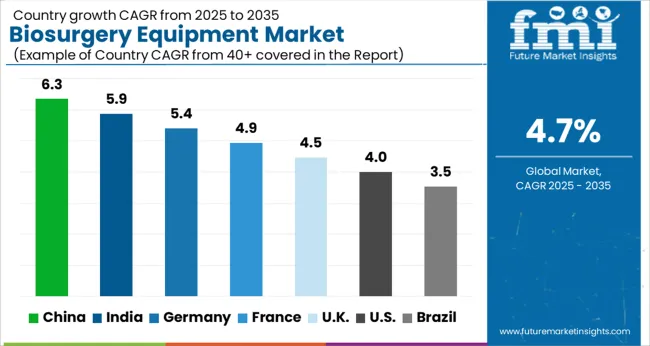
| Country | CAGR |
|---|---|
| China | 6.3% |
| India | 5.9% |
| Germany | 5.4% |
| France | 4.9% |
| UK | 4.5% |
| USA | 4.0% |
| Brazil | 3.5% |
The Biosurgery Equipment Market is expected to register a CAGR of 4.7% during the forecast period, exhibiting varied country level momentum. China leads with the highest CAGR of 6.3%, followed by India at 5.9%. Developed markets such as Germany, France, and the UK continue to expand steadily, while the USA is likely to grow at consistent rates. Brazil posts the lowest CAGR at 3.5%, yet still underscores a broadly positive trajectory for the global Biosurgery Equipment Market. In 2024, Germany held a dominant revenue in the Western Europe market and is expected to grow with a CAGR of 5.4%. The USA Biosurgery Equipment Market is estimated to be valued at USD 10.3 billion in 2025 and is anticipated to reach a valuation of USD 15.3 billion by 2035. Sales are projected to rise at a CAGR of 4.0% over the forecast period between 2025 and 2035. While Japan and South Korea markets are estimated to be valued at USD 1.4 billion and USD 958.9 million respectively in 2025.
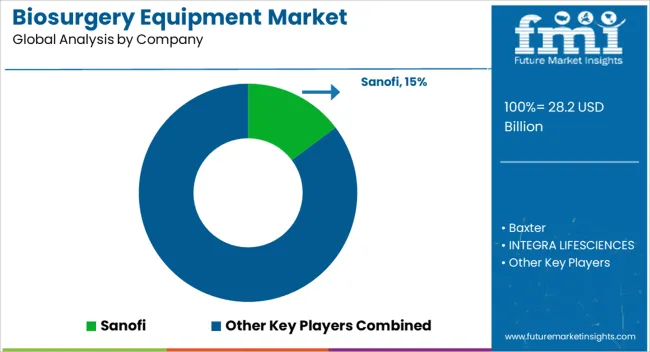
| Item | Value |
|---|---|
| Quantitative Units | USD 28.2 Billion |
| Product Type | Bone Graft Substitute, Surgical Sealants, Hemostatic Agents, Soft Tissue Management, and Adhesion Barriers |
| Application | Cardiovascular, Orthopedic, Neurological, Urology, General Surgery, Plastic Surgery, and Gynecological |
| End Users | Hospitals, Clinics, Ambulatory Surgical Centers, Diagnostic centers, Cardiac Catheterization Laboratories, and Home Care Settings |
| Regions Covered | North America, Europe, Asia-Pacific, Latin America, Middle East & Africa |
| Country Covered | United States, Canada, Germany, France, United Kingdom, China, Japan, India, Brazil, South Africa |
| Key Companies Profiled | Sanofi, Baxter, INTEGRA LIFESCIENCES, Medtronic, B. Braun SE, Pfizer Inc, Stryker, Johnson & Johnson Services, Inc, BD, and Artivion, Inc (CryoLife, Inc.) |
The global biosurgery equipment market is estimated to be valued at USD 28.2 billion in 2025.
The market size for the biosurgery equipment market is projected to reach USD 44.6 billion by 2035.
The biosurgery equipment market is expected to grow at a 4.7% CAGR between 2025 and 2035.
The key product types in biosurgery equipment market are bone graft substitute, surgical sealants, hemostatic agents, soft tissue management and adhesion barriers.
In terms of application, cardiovascular segment to command 22.1% share in the biosurgery equipment market in 2025.






Our Research Products

The "Full Research Suite" delivers actionable market intel, deep dives on markets or technologies, so clients act faster, cut risk, and unlock growth.

The Leaderboard benchmarks and ranks top vendors, classifying them as Established Leaders, Leading Challengers, or Disruptors & Challengers.

Locates where complements amplify value and substitutes erode it, forecasting net impact by horizon

We deliver granular, decision-grade intel: market sizing, 5-year forecasts, pricing, adoption, usage, revenue, and operational KPIs—plus competitor tracking, regulation, and value chains—across 60 countries broadly.

Spot the shifts before they hit your P&L. We track inflection points, adoption curves, pricing moves, and ecosystem plays to show where demand is heading, why it is changing, and what to do next across high-growth markets and disruptive tech

Real-time reads of user behavior. We track shifting priorities, perceptions of today’s and next-gen services, and provider experience, then pace how fast tech moves from trial to adoption, blending buyer, consumer, and channel inputs with social signals (#WhySwitch, #UX).

Partner with our analyst team to build a custom report designed around your business priorities. From analysing market trends to assessing competitors or crafting bespoke datasets, we tailor insights to your needs.
Supplier Intelligence
Discovery & Profiling
Capacity & Footprint
Performance & Risk
Compliance & Governance
Commercial Readiness
Who Supplies Whom
Scorecards & Shortlists
Playbooks & Docs
Category Intelligence
Definition & Scope
Demand & Use Cases
Cost Drivers
Market Structure
Supply Chain Map
Trade & Policy
Operating Norms
Deliverables
Buyer Intelligence
Account Basics
Spend & Scope
Procurement Model
Vendor Requirements
Terms & Policies
Entry Strategy
Pain Points & Triggers
Outputs
Pricing Analysis
Benchmarks
Trends
Should-Cost
Indexation
Landed Cost
Commercial Terms
Deliverables
Brand Analysis
Positioning & Value Prop
Share & Presence
Customer Evidence
Go-to-Market
Digital & Reputation
Compliance & Trust
KPIs & Gaps
Outputs
Full Research Suite comprises of:
Market outlook & trends analysis
Interviews & case studies
Strategic recommendations
Vendor profiles & capabilities analysis
5-year forecasts
8 regions and 60+ country-level data splits
Market segment data splits
12 months of continuous data updates
DELIVERED AS:
PDF EXCEL ONLINE
Equipment Management Software Market Size and Share Forecast Outlook 2025 to 2035
Equipment cases market Size and Share Forecast Outlook 2025 to 2035
Farm Equipment Market Forecast and Outlook 2025 to 2035
Golf Equipment Market Size and Share Forecast Outlook 2025 to 2035
Port Equipment Market Size and Share Forecast Outlook 2025 to 2035
Pouch Equipment Market Growth – Demand, Trends & Outlook 2025 to 2035
Garage Equipment Market Forecast and Outlook 2025 to 2035
Mining Equipment Industry Analysis in Latin America Size and Share Forecast Outlook 2025 to 2035
Subsea Equipment Market Size and Share Forecast Outlook 2025 to 2035
Pavers Equipment Market Size and Share Forecast Outlook 2025 to 2035
Tennis Equipment Market Analysis - Size, Share, and Forecast Outlook 2025 to 2035
Galley Equipment Market Analysis and Forecast by Fit, Application, and Region through 2035
Sorting Equipment Market Size and Share Forecast Outlook 2025 to 2035
General Equipment Rental Services Market Size and Share Forecast Outlook 2025 to 2035
Bagging Equipment Market Size and Share Forecast Outlook 2025 to 2035
RF Test Equipment Market Size and Share Forecast Outlook 2025 to 2035
Medical Equipment Covers Market Size and Share Forecast Outlook 2025 to 2035
Telecom Equipment Market Size and Share Forecast Outlook 2025 to 2035
Welding Equipment And Consumables Market Size and Share Forecast Outlook 2025 to 2035
Hunting Equipment and Accessory Market Analysis - Size, Share, and Forecast Outlook 2025 to 2035

Thank you!
You will receive an email from our Business Development Manager. Please be sure to check your SPAM/JUNK folder too.
Chat With
MaRIA